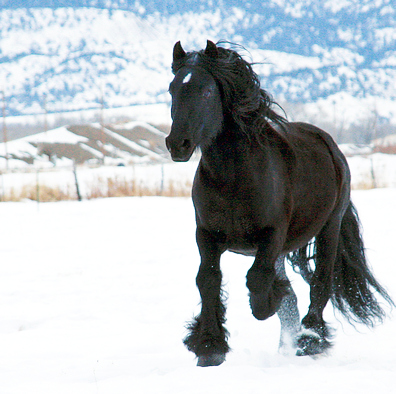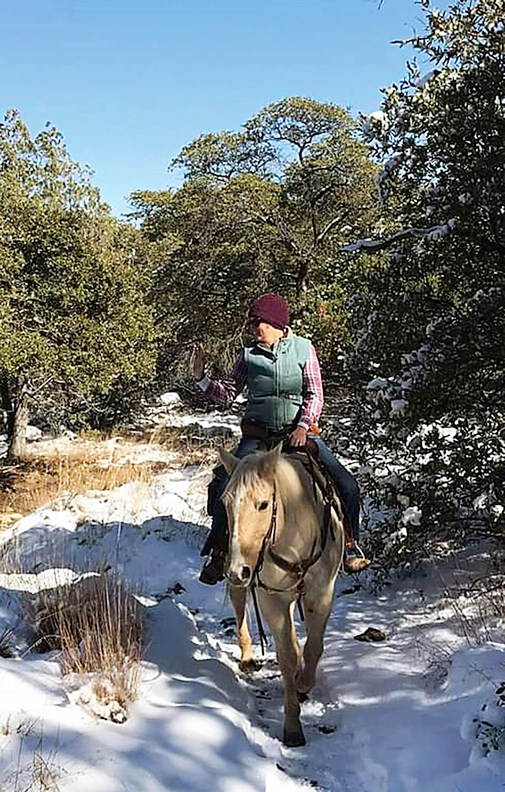By Rita Thompson-Tinsley

Being wise when cold weather comes, we winterize vehicles, insulate our homes and put on layer upon layer before venturing out. A little known fact is that your horse actually LOVES snowy winter weather, though it can mean more maintenance for us. Although the Prescott area isn‘t known for its Eskimo climate, it‘s still very wise to prepare your equines for the big chill.
Winter preparation is determined by the type of horse you have, his age, and his barn/pasture environment. If you have a show horse that is body clipped, you want to invest in a winter blanket and should be using the blanket when temperatures get below 60°F, or anytime it‘s rainy or windy, according to author Sallie S. Hyman, VMD, DACVIM, CVA, of Equestrian Collections. However, if you have a trail horse or any equine that can develop a nice winter coat, you will probably never need a winter blanket to keep him warm.
Your horse is designed by nature to have his own dynamic cooling/heating system that’s controlled by two types of hair and a muscle. According to Dr. Hyman, horses’ coats are comprised of longer, stiffer guard hairs and soft, fluffy undercoats.
The guard hairs protect the soft hairs from dirt and rain and collect moisture from sweat that might damage the undercoat. The softer, fluffier undercoat traps warm air functioning as insulation. Natural oils coat the hair to make them water resistant.

Each hair is connected to the piloerector muscle, which allows the hair to rise up or lay flat. When they stand up, warm air is trapped between them. When they lie down, warm air is released, cooling the area. A Canadian study revealed that horses can tolerate temperatures as low as 5°F before they show any drop in body temperature. There are, however, two game changers: rain and wind.
Rain can flatten the hair, which prevents the undercoat from providing the layer of warm air. Wind can blow the warm air from the surface. Snow is less of a problem; according to Hyman‘s study, snow will collect and act as a layer of insulation. So the only time you should be blanketing a horse is: If he‘s clipped, sick or injured, underweight, geriatric, recently moved to a colder climate, or if no shelter is available.
Now that you know what to put ON your horse (or not) for winter, what should you put IN your horse BEFORE winter? Standlee‘s Beyond the Barn podcast with Dr. Tania Cubitt, and several reliable trainers/ranchers I have interviewed, recommend you FEED THE HORSE!!! Do not let Silver or Buttercup go into winter on zip or zero.
Friend and experienced horse trainer at The Blake Brothers Ranch Gypsies (Gypsy Vanners) in Bowie, Texas, Dawn Chambers explains, “We evaluate our broodmares for weight regularly, but with all of our horses, we make sure they go into winter a little fat.“

Blake Brothers Ranch plans ahead; they feed extra grain ahead of winter and they make sure that everyone has constant access to hay.
Tania Cubitt, PhD, on Beyond The Barn emphasizes increased forage. “Helping horses thrive during the wintertime includes increasing their intake of hay.“
She provides a guide for the increase: 1% to 1-1/2%, and up to 2% of their body weight. For example, you need to feed 15-25 lbs. of hay a day to a 1,000-lb. horse.
“Remember, the horse is burning more calories to maintain body heat,“ says Cubitt. Hay is considered the best fiber and the best source of heat production, above grain or any kind of mash your grandma told you about. Also, make sure your horses are drinking water.
Now for the mammoth shocker. There are herds of horses in really cold regions, unblanketed and out on open land. Montana, Wyoming, the Dakotas are just a few states where you will see this means of winterWIZING. This has been a common practice for centuries.

According to a North Dakota rancher, her horses easily survive by huddling under trees. The horses she keeps in her barn stalls are blanketed because they have no one to huddle with. Creeks or a river with running water ensure refreshment, and horses can sometimes open frozen water with a kick of the hoof. It‘s not their first rodeo, and whenever you see a dramatic exhibition of frisky dancing and prancing, this is actually a natural way for your horse to initiate heat.
Diana Graveley, ranch manager of her family ranch and farm for 45 years, shared with me their horse set up. They didn’t have a running creek or river on the property, so they relied on troughs mostly. They didn’t have a barn, but relied on lean-tos and one big shed for a windbreak, and put down lots of straw for bedding.
Mrs. Graveley claims to have blanketed a horse just once. Meg Goodyear of Chino Valley worked on the Graveley Ranch for just under two years and can tell chilling stories of what it‘s like to look for newborn calves at 20-30°F below zero, something you and I may never have to do.
All in all, it‘s not difficult to be winterWIZE as long as you know your barnyard buddies and some hot tips for the cold season.

